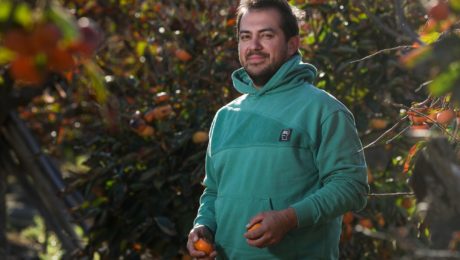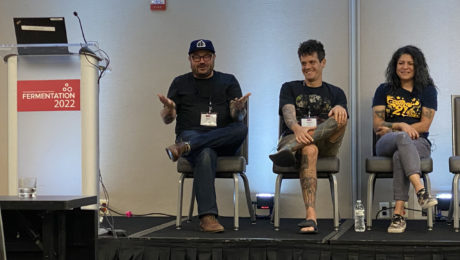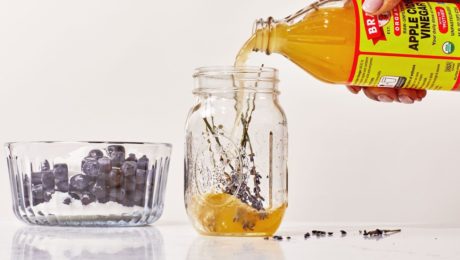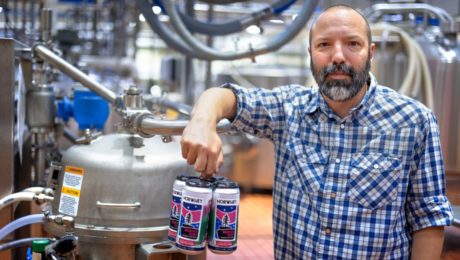Ugly Fruit into Delicious Kombucha
A new Los Angeles-based kombucha brand has a unique approach to their fermented tea. Sunset Cultures owner and chef Balo Orozco (pictured) uses the unsold or “ugly” fruits and vegetables from local farms into “some of L.A.’s most creative kombuchas, hot sauces and condiments.”
Staying true to his goal of curbing food waste and helping local farmers is certainly not easy. Orozco spends much of his days driving across the state to pick up boxes or pallets of produce that would otherwise be thrown away or composted. Another challenge: the kombucha flavors and condiment offerings change with the amount and type of surplus product Orozco receives from farmers. (Sunset Cultures does consistently sell four core kombucha flavors).
Orozco’s roots are in the restaurant industry. As a chef, he was alarmed at the amount of kitchen waste restaurants would throw away. His specialty soon switched to reusing kitchen scraps and fermenting house-produced condiments. After the last restaurant he worked at folded due to the pandemic, he began working on Sunset Cultures.
Sunset Cultures products are always changing and adapting based on available products. In the last six months, Sunset Cultures began making jam, a solution to their own wasted byproduct from the lightly boiled strawberries used in their kombucha.
Sunset Cultures products are currently sold in 40 retail shops and online, with plans to expand to other cities in 2023.
Read more (Los Angeles Times)
- Published in Food & Flavor
Upcycling & Zero Waste
Fermentation is a powerful culinary tool for upcycling.
During the Upcycling and Zero Waste session at FERMENTATION 2022, six fermentationists with diverse backgrounds in the industry shared how they’re using fermentation to reduce food waste.
“As a chef, we are constantly chasing these depths of flavors and things that you can’t get in regular cooking applications or techniques. Fermentation opened up a whole new world of flavor,” says Jessica Alonzo, a fermentation specialist and owner of small batch ferments company Native Ferments in Texas. “We were looking to enhance diner’s experience and fermentation did that.”
The panelists from all over the world included: Alonzo, Jeremy Kean (chef/owner of Brassica Kitchen), Mac Krol (CEO/founder of Mac Ferments), Richard Preiss (cofounder and brewing scientist at Escarpment Labs), Michelle Ruiz (CEO/co-founder of Hyfé Foods) and Ismail Samad (founder of Loiter and Wake Robin Foods).
Aiding farmers
Alonzo consults with area restaurants to build unique larders. She helped create the fermentation and whole food utilization program at Petra and the Beast as the former sous chef. Fermenting the restaurant byproducts helped the restaurant eliminate food scraps, cut down on food cost and partner with farmers.
Up to 40% of food grown in America is thrown away, according to the U.S. Department of Agriculture.
“I got into zero waste and upcycling through relationships with farmers, seeing how much was wasted at the farm level,” says Samad, who also co-founded and was executive chef at The Gleanery in Vermont. “The Gleanery existed for the last 12 years to provide a very clear safety net for farmers not selling their stuff at the farmers market.
Samad admits he didn’t know much about fermentation when he first started, “We just knew we didn’t want to keep wasting food.” By fermenting the kitchen scraps, “we’re making sacrifices that big food won’t do.”
Exploring Science
At a scientific level, Preiss at Escarpment is looking at upcycling “through a microbiologist lens.” Preiss said he began upcycling when he realized the current food system is unsustainable in a linear economy.
“There’s a lot of opportunity for creating circular food economies to not only reduce waste but help every single stakeholder involved in this process make more money, pay people more, create jobs, be more profitable and ultimately stay open as part of the sustainability discussion,” he says.
Restaurants are often leading upcycling and fermentation conversations – “many people know about fermentation because of restaurants.” But Preiss says the craft beer industry is becoming a leader in the upcycling movement because, today, they’re in many neighborhoods. “They have a really cool platform to communicate new ideas around food innovation.”
Escarpment is exploring interesting ways to use spent grains from beer. Currently, they’ve created a way to make seasonings. Brewers use those seasonings in their menu dishes, a novelty that gets customers excited about pairing a beer with a dish seasoned with that craft brew’s spent grain.
“There’s a lot of opportunity in that grain, there’s still a lot of nutritional quality,” Preiss says. “Through fermentation, we unlock new possibilities.”
Hyfé Foods is also utilizing waste. They’re taking the discarded sugar water (typically used in beverage production) and, through fermentation, repurposing it in mycelium flour. Mycelium is a type of mushroom. Hyfé’s proprietary biotechnology makes a protein-rich, low carb mycelium flour in a carbon-neutral, affordable process.
“Often when a manufacturer makes a product, the lifecycle being considered ends at the door. We’re often not measuring the greenhouse gas emission impact, the wasted sugar water – that goes down the drain,” says Ruiz. Food manufacturers pay a hefty fee to get rid of waste water. “We’re really excited about the position that upcycling puts us in, not only from a cost standpoint but also we’re creating a really nutritious, low cost food.”
Upcycling Barriers
Upcycling is not without its challenges.
Kroll at Mac Ferments specializes in koji. He recently created shoyu made with used coffee grounds, koji, water and salt – an excellent choice, he says, for a restaurant that likely throws out pounds of coffee grounds at the end of the night.
“It is obviously nice to create added volume from leftovers, it tightens the whole supply chain,” Kroll says. “But also there are risks of potentially overproducing just to create extra waste. You have to be careful what you’re doing because you’re dealing with enzymes – and we don’t see microbes.”
Fermentation, he says, should be utilized for quality, not quantity.
“If every dish has something fermented, a regular customer might come home starving,” Kroll adds.
Preiss sees collaboration as a major challenge because creating a circular, upcycled system involves multiple stakeholders sharing their waste products.
“Upcycling can’t be done in a silo, you need collaboration, and getting people that have the different pieces of the puzzle together to make it happen is the biggest challenge,” he says.
Samad, meanwhile, says scaling is a hurdle. “There are opportunities for investments around upcycling, but there’s a ceiling where this culture or ethos can be sustained.”
Educating customers, too, can be tricky. The public consuming the product or dish needs to understand what is upcycled. Servers, as the mouthpiece to diners, must taste and know a dish to communicate its elements. Chefs must detail to servers where ingredients were sourced, how long the food was aged and what was cross utilized, Alonzo says.
Panelists said the public is excited about the new taste experiences with upcycled food – but they’re also more curious about the science behind it.
“Folks come into Brassica for that fermentation program and are so interested and hungry for that knowledge from the science community,” Kean says. “And then theres folks that just want to eat and say ‘What the fuck was that?’ I think it’s a mixture between the two.”
“The education around all this stuff is growing,” he adds. “I see the culinary world and science world getting closer and closer together and I think that’s the right direction.”
- Published in Food & Flavor, Science
Fermented Flavor Development in Restaurants
In the last decade, fermentation has taken center stage at fine dining restaurants. How do owners and chefs develop and maintain a fermentation program for their kitchen?
An all-star team of U.S. chef-owners at FERMENTATION 2022 shared their successes and failures in developing fermentation-focused kitchens. Speakers included: Sean Brock of Audrey Restaurant in Nashville, Jeremy Kean of Brassica Kitchen in Boston and Misti Norris of Petra & the Beast in Dallas. Jori Jayne Emde, chef, educator and owner of Corner Office in Taos, New Mexico, moderated the discussion.
The chefs all focus on whole food utilization, aiming to eliminate food waste in flavor-packed dishes. Fermentation is key. Food scraps that would otherwise be thrown out – stems from produce, coffee grounds or animal bits – are fermented and reinvented in flavorful, unique dishes.
“By reusing the product in different manipulations over and over again, this type of program can really develop branding potential over time,” Emde says. “The process of bringing several lives to one product puts one’s fingerprint on the cuisine, so the restaurant expresses its own terroir.”
In-House Fermentation
Core to developing a restaurant fermentation program is assigning someone to oversee the process. Who will track the start dates, monitor pH levels and control filtration?
Emde, who formerly ran Fish & Game in New York’s Hudson Valley, quickly learned at the restaurant “you can’t just have a multitude of chefs handling it…ferments are alive and require being nurtured and cared for.”
Brock agrees, noting some restaurants have their chef de cuisine or sous-chef head up fermentation efforts. “But the reality is they have so much to do already.”
“It’s critical to have someone dedicated to the program,” Brock says. “When you’re having to build such a renegade operation, the biggest challenges are keeping up with inventory and monitoring each ferment.”
Audrey hired a fermentation specialist in 2014, Elliot Silber. He has a chemistry degree and “understands fermentation at a completely different level,” Brock says.
“I still can’t believe we have someone in charge of fermentation,” he adds. “Now, we put fewer things on the plate with a bigger impact. I get to finally produce food I would consider minimalist.”
Brassica Kitchen takes a different approach to their fermentation program – a food map.
“We’ve been running fermentation forward cuisine for about 10 years and, in that 10 years, we’ve gone through a lot failure and chaos and really kind of developing things as we go, to changing the menu everyday to coming in long before service to staying long after to doing inventory and plug and play with them. We hit a wall,” Kean says. “We’ve found ourselves looking at over 100 misos and going ‘What the fuck do we do with this?’”
The kitchen’s food map is a shared document where the chefs outline how to utilize every byproduct. It’s been Brassica’s most effective menu-planning solution. “This food map has solved a lot of the problems and created a box of creativity we can really thrive in,” Kean says.
Health Department Woes
When Brock launched his first fermentation program at Charleston’s Husk restaurant in 2010, “ironically our biggest challenge was the health department,” Brock said. “They would make us throw food away.”
Health department officials – many who had no idea what fermentation was or its inherent safety – would immediately issue violations for any food sitting on a counter at room temperature, a normal process for fermenting foods or beverages. Husk maintained a makeshift lab on the roof of the restaurant hidden from officials, and staff had a code word for when the health department would come to the restaurant.
Norris recalled instances where inspectors would pour bleach on their fermented food products or throw their meat in the trash.
“It’s hard because we’ve taken the time to learn and be knowledgeable about how to keep these foods safe. And then someone comes in who is supposed to be keeping people safe but has no knowledge of food and we’re trying to make food healthier and keep it more dynamic and sustainable,” Norris says. “It’s frustrating when you put so much of yourself and your philogosphy into the food.”
Audience Acceptance
Today – as fermentation is featured regularly in food, health and science news – diners are eager to eat unique, fermented dishes. This hasn’t always been the case. Even today,diners need to trust a restaurant before they will buy dishes experimenting with fermentation. Norris notes, when Petra and the Beast first opened, fermentation was not a food trend in Texas. Residents had not grown up with a food culture of eating and preserving wild food.
“It definitely did not happen overnight,” she says. “It took a lot of educating and reassuring people that these things are delicious and they are a little uncommon, a little different. It’s something that took time and effort to understand what we were doing with full utilization and sustainability.”
Kean, too, said it took time at Brassica.
“We’d be using all these (fermented) products and I wouldn’t even mention it on the menus,” he said. “The trust was built over all these years and until we could really start speaking on it.”
Eliminating food waste was mentioned as fermentation’s gateway of acceptance for diners.
Food Waste into Food
Brock says the goal at Audrey is to find 10 uses for every seasonal, region-specific ingredient. For example, last year they received candy roaster squash from a local farm and served it in different forms in dishes throughout the fall season. But they also fermented it and will be serving it again this year.
“We don’t create dishes and then get the ingredients,” Brock says, “the ingredient fuels the dish.”
The kitchen at Audrey is full of glass-encased ferments, each organized by parts of the tongue.
Brassica has found success in utilizing food waste by creating delicious dishes that are “black holes for the extra stuff” Kean says. For example, they serve a fried rice dish using sticky rice from the day before with fermented vegetables. The dish is popular, low cost and “encourages little things that can be vehicles in a dish.”
“It’s been inspiring over the years to find a use for the byproducts, then the byproducts become so important that you have to then buy the byproduct,” he says. “It’s happened to us over and over again.”
Petra and the Beast focuses on whole animal utilization. By being sustainable and “hyper-seasonal,” Norris says, Petra is “creating food with the most depth, creating food that’s not just one note.”
“I ask myself and the team ‘Well, what should we do with it? Is there a better use for it? Is there a sour brine or can we make a salt out of it and use it on that same vegetable next season?’” Norris says. “If you really truly understand why a flavor profile is developing in a certain way, you look at everything else differently.”
- Published in Food & Flavor
Why did Americans Turn to Drinking ACV?
A deep dive on Epicurious explores how apple cider vinegar (ACV) became America’s favorite. It is popular today as a detox tonic, but has a deep history in the U.S., “intertwined with the global spread of apples and with the transformations of fermentation.”
Today, vinegar is considered an industrialized condiment but, until the 19th Century, it was homemade. Kirsten Shockey, author of Homebrewed Vinegar (and a TFA Advisory Board member) notes the key to making vinegar is nurturing the natural fermentation process. “Vinegar happens whether you want it to or not,” she says. “As soon as fruit is picked, it’s a race against time,” she adds. As the fruit ripens, wild yeasts ferment their sugars into alcohol. Microbes feast on that alcohol, converting it to acetic acid.
Paul C. Bragg, namesake of the Bragg vinegar brand, helped popularize commercial vinegar. Theirs is still a raw, unpasteurized ACV. Paul preached the benefits of vinegar as far back as in the 1970s. This support coincided with “the rise of a countercultural natural food movement, which embraced the brown, gritty and ‘all-natural’ in its refusal of the refined, bleached and heavily processed products of the industrial food system.” (Pop star Katy Perry invested in Bragg in 2019).
The article also highlights artisanal vinegar brands, like American Vinegar Works in Massachusetts and two Pennsylvania producers, Supreme and Keepwell.
Isaiah Billington cofounder of Keepwell says that making vinegar “helps us interact closely with the total landscape of local agriculture.” Vinegar also uses produce that can’t be sold because it’s too ripe, or because the apple is “very ugly.” “We work at the margins of the harvest.”
Read more (Epicurious)
- Published in Food & Flavor
Chicago: A Fermentation Hub
If you still think of hot dogs and deep dish pizza as the icons of Chicago’s culinary scene, you need to think again. The so-called Capital of the Midwest is a hub of innovation in the food industry. Chicago has the largest food and beverage production in the U.S., with an annual output of $9.4 billion. Food startup companies in the region raised $723 million in venture capital last year.
“Chicago is one of the most diverse cities for eating,” says Anna Desai, Chicago-based influencer of Would You Like Something to Eat on Instagram. ”Our culinary scene is constantly elevating and evolving. We are always just a neighborhood or tollway away from experiencing a new culture and cuisine. I’m most excited when I find an under-the-radar spot or discover a maker who can pair flavors and ingredients that get you curious and wanting more.”
Desai started her blog in part because she wanted to champion the Asian American and Pacific Islanders (AAPI) community in the Chicago food and beverage scene. “Food has long served as a cultural crossroad,” she adds, and Chicago’s multicultural cuisine exemplifies that sentiment.
Chicago is home to some of the most creative minds in fermentation, from celebrity chefs, zero waste ventures, alternative protein corporations and the world’s largest commercial kefir producer. There are dozens of regional and artisanal producers lacto-fermenting vegetables, brewing kombucha and experimenting with microbes in food and drink.
“Chicago is a great food city in its own right, so naturally there is a ton of talent in the fermentation space,” says Sam Smithson, chef and culinary director of CultureBox, a Chicago-based fermentation subscription box. “The pandemic’s effect on restaurants has also spawned a new wave of fermenters (ourselves included) that are looking for a path outside the grueling and uncertain restaurant structure to display our creative efforts. This new wave is undoubtedly community-motivated and concerned more with mutual aid than competition. There is a general feeling that we are all working towards the same goal so cooperation and collaboration is soaring and we are seeing incredible food come from that.”
Flavor is King
Flavor development is still the prime motivation for chefs to experiment with fermentation. A good example is at Heritage Restaurant and Caviar Bar in Chicago’s Humboldt Park neighborhood.
“Fermentation has been a cornerstone of the restaurant since its inception,” says Tiffany Meikle, co-owner of Heritage with her husband, Guy. “With the diverse cuisines we pull from, both from Eastern and Central Europe and East Asia, we researched fermentation methodologies and histories, and started to ‘connect the dots’ of each culture’s fermentation and pickling backgrounds.”
Menus have included sourdough dark Russian rye bread, toasted caraway sauerkraut, kimchi made from apples, Korean pears and beets and a kimchi using pickled ramps (wild onions). Heritage has also expanded their fermentation program to the bar, where they’ve created homemade kombucha, roasted pineapple tepache, sweet pickled fruits for cocktail garnishes, and kimchi-infused bloody mary mix.
“It’s fascinating to me that there are so many ingredients you can use in a fermented product,” says Claire Ridge, co-founder of Luna Bay Booch, a Chicago-based alcoholic kombucha producer. “People are really experimenting with interesting ingredients in kombucha…I have seen brewers do some of the wildest recipes and some recipes that are very basic.”
Innovating Food
Chicago-based Lifeway Kefir is indicative of the innovation taking place in the city. Last year the company expanded into a new space: oat-based fermentation, launching a dairy-free, cultured oat milk with live and active probiotics.
“We’ve spent so many years laying the groundwork in fermented dairy,” says Julie Smolyansky, CEO. “Now we’re experimenting and expanding to see what’s over the next horizon, though we’ll always have kefir as our first love.”
Chicago is home for two inventive fermented alternative protein startups: Nature’s Fynd and Hyfé Foods. Both companies were born out of the desire to create alt foods without damaging the environmental.
“Conscious consumerism is a trend that’s driving many people to try alternative proteins, and it’s not hard to understand why,” says Debbie Yaver, chief scientific officer at Nature’s Fynd. The company uses fermentation technology to grow Fy, a nutritional fungi protein. “Fungi as a source of protein offer a shortcut through the food chain because they don’t require the acres of land or water needed to support plant growth or animal grazing, making fungi-based protein more efficient to produce than other options.”
Alternative foods outlasting the typical trend cycle is a challenge for companies like Nature’s Fynd. When grown at scale, Fy uses 99% less land, 99% less water and emits 94% fewer greenhouse gasses than raising beef. But, to make an impact, “we need more than just vegans and vegetarians to make changes in their diets,” Yaver adds.
Waste Not
Numerous companies are using fermentation as a means to eliminate waste. Hyfé Foods, another player in the alternative protein space, repurposes sugar water from food production to create a low-carb, protein-rich flour. Fermentation turns a waste product into mycelium flour, mycelium being the root network – or hyphae (hence the company name) — of mushrooms.
“[We’re] diverting input to the landfill and reducing greenhouse gas emissions at scale,” says Michelle Ruiz, founder. “Hyfé operates at the intersection of climate and health, enabling regional production of low cost, alternative protein that reduces carbon emissions and is decoupled from agriculture.”
Symmetry Wood is another Chicago upcycler. They convert SCOBY from kombucha into a material, Pyrus, that resembles exotic wood. Founder Gabe Tavas says Pyrus has been used to produce guitar picks, jewelry and veneers. Symmetry uses the discarded SCOBY from local kombucha brand Kombuchade.
Many area restaurants and culinary brands also use fermentation to preserve food for the long Chicago winters, when local produce isn’t available. Pop-up restaurant Andare, for example, incorporates fermentation into classic Italian dishes.
“Finding ways to utilize what would otherwise be waste products inspired our initial dive into fermentation. The goal is not just to use what’s leftover, but to make it into something delicious and unique,” says Mo Scariano, Andare’s CEO. “One of our first dishes employing koji fermentation was a summer squash stuffed cappellacci served with a butter sauce made from carrot juice fermented with arborio rice koji. Living in a place with a short grow season, preservation through fermentation allowed us access throughout the year to ingredients we only have fresh for a few weeks during the summer.”
Industry Challenges
Despite growing interest and increasing sales, fermenters face some significant hurdles.
Smithson at CultureBox says he sees that consumers are open to unorthodox, less traditional ferments. Though favorites like kombucha and sauerkraut dominate the market, “their share is being encroached on by increasingly more varied and niche ferments.” But getting these products to market can be a challenge. Small-scale, culinary producers are challenged by the regulatory hoops they need to jump through to legally sell ferments – especially unusual ones a food inspector doesn’t recognize.
“The added layer of city regulations on top of state requirements, sluggish health department responses, and inflexible policy chill the potential of small producers,” Smithson says. But he highlights the recently-passed Home-to-Market Act of Illinois as positive legislation helping startup fermenters.
Consumer awareness and education are also vital. “Many longstanding and harmful misconceptions on the safety and value of fermented products still exist,” Smithson says.
Matt Lancor, founder and CEO of Kombuchade makes consumer education a core part of marketing, to align kombucha as a recovery drink.
“Most mainstream kombuchas are marketed towards the yoga/crystal/candle crowd, and I saw a major opportunity to create and market a product for the mainstream athletic community,” he says. “We’re on a mission to educate athletes and the general public about these newly discovered organs [the gut] – our second brain – and fuel the next generation of American athletes with thirst quenching, probiotic rich beverages.”
Product packaging provides much of a consumer’s education. Jack Joseph, founder and CEO of Komunity Kombucha, says simplicity is key.
“People are more conscious of their health now, more than ever before,” he says. “So now it comes down to the education of the product and creating something that is transparent and easy for the consumer to digest.”
Sebastian Vargo of Chicago-based Vargo Brother Ferments agrees.
“Oftentimes food is considered ‘safe’ due to lack of microbes and how sterile it is,” he says. “Fermentation eschews the traditional sense of what makes food ‘safe’. We need to create a set standardized guide for fermented food to follow, and change our view of living foods in general. One of the brightest spots to me is the fact that fermentation is really hitting its stride and finding its place in the modern world, and I don’t see it going anywhere but up in the near future.”
- Published in Business, Food & Flavor
Hard Seltzer from Whey?
A professor of food science at Cornell University has launched a unique food product: a hard seltzer made from yogurt byproduct.
The seltzer, Norwhey, started as part of an academic research project by food scientist Sam Alcaine, who works in the Fermentation Lab at Cornell’s College of Agriculture and Science. It all began in 2016 when the New York Department of Environmental Conservation asked Cornell to solve a problem. The state, the largest producer of yogurt in the country, was concerned with the large amount of waste (whey) being thrown away. For every one cup of yogurt made, three cups of byproduct are produced.
That amounts to a huge amount of waste, with up to a billion pounds of whey produced each year just in the state of New York, Alcaine told Good Beer Hunting. The article notes that Greek yogurt producer Chobani alone generates 50 truckloads of whey per day.
“There is a lot of lactose floating out there, and I wanted to find out how we could ferment that in new and novel ways,” Alcaine said.
Historically, whey has been considered worthless since it contains no protein. But It does still have the vitamins found in milk — calcium, potassium, zinc, magnesium and vitamin B5— which spurred Alcaine to research how why could be made into something of value.
“In the brewing world, we’ve always looked for developing better-for-you products,” said Alcaine, who co-founded Denver’s Doc Luces Brewery and worked in new product development at Miller Brewing Company. “It’s been kind of a hard space to play in, with alcohol. So this is an opportunity. We just have to make it taste good.”
“There are actually some old stories around that, in Iceland, they would take the whey from skyr [a cultured dairy product similar to curd cheese] and they would put it into these barrels,” Alcaine said in a Cornell press release on Norwhey. “It would age and it would become alcohol. But it hadn’t been done in my lifetime.”
Norwhey is made by adding the enzyme lactase to whey, which breaks lactose into glucose and galactose. These sugars are then fermented traditionally.
Alcaine partnered with Trystan Sandvoss, founder of First Light Creamery and then Marketing Director at Old Chatham Creamery, to create Norwhey. The pair entered a food and agriculture competition, Grow-NY, in 2020, and made it to the final round. That same year, they secured $50,000 in funding from the FuzeHub Commercialization Competition, and used the prize money to test batches and can and label products at New York-based Meier’s Creek Brewing.
Norwhey was first available at retail in April at New York-based Wegmans grocery stores. The hard seltzer is currently offered inthree flavors: Glacial Ginger, Solar Citrus and Mountain Berry, all with an ABV of 4%. There are plans to open a taproom and to experiment with new flavors this summer.
Cornell notes Norwhey is a “triple threat.” The alcoholic drink has a better nutritional profile than beer, it recycles waste material and “it could eventually act as a model for dairy farmers looking for additional revenue.”
For his part, Alcaine says he does not want to quit his day job and become a business owner. He wants to remain a professor and a researcher. But he’s hoping people will copy his idea, building “a whey-based economy in New York” and a more sustainable yogurt industry globally.






